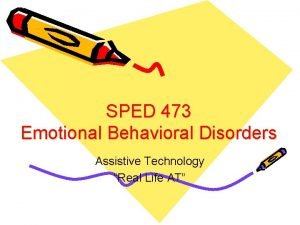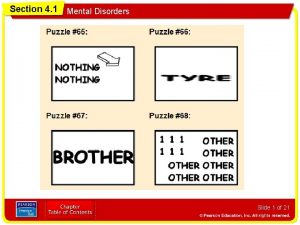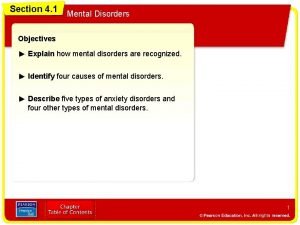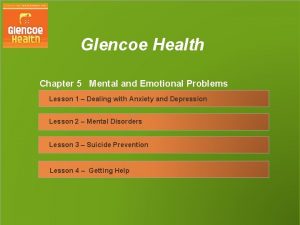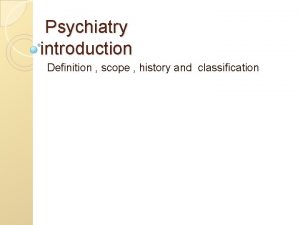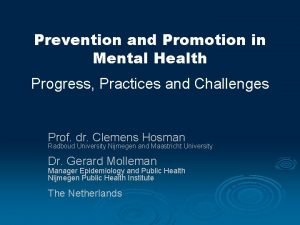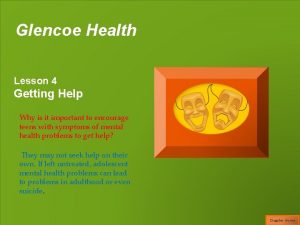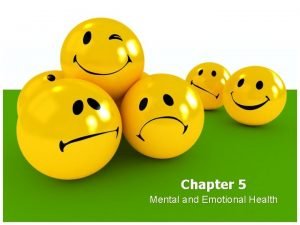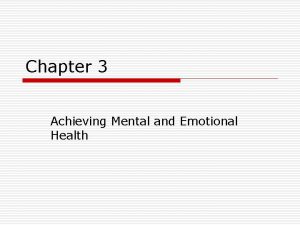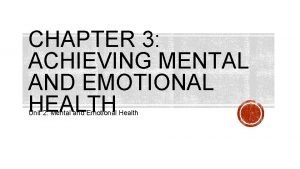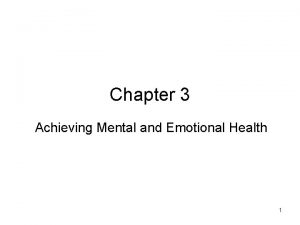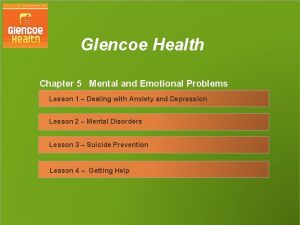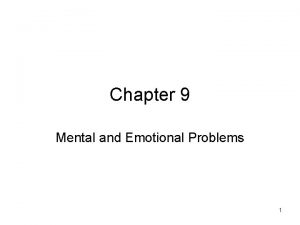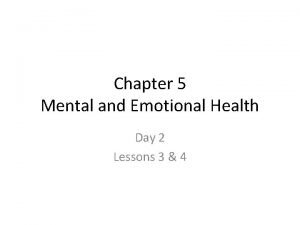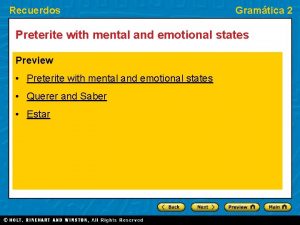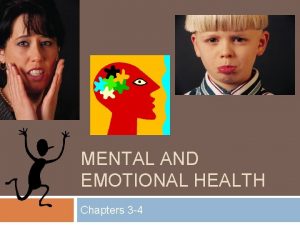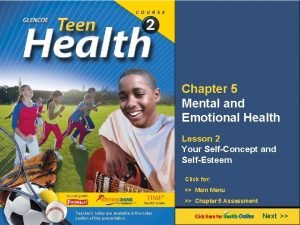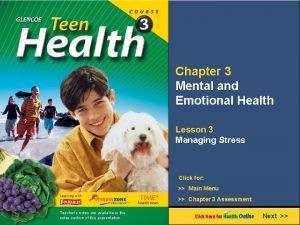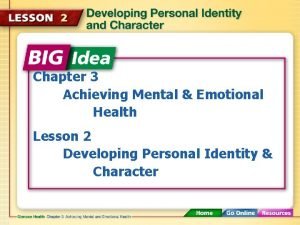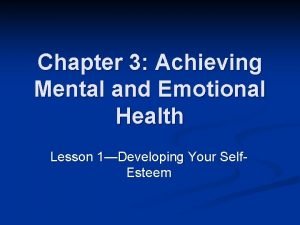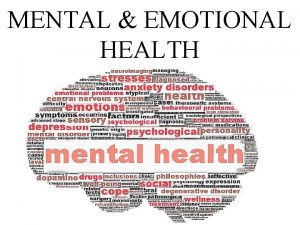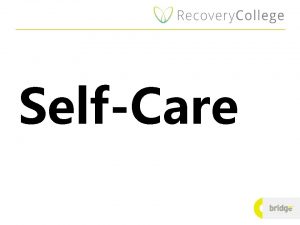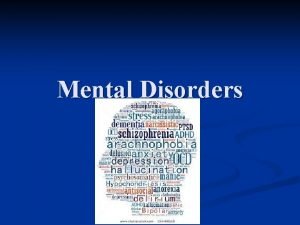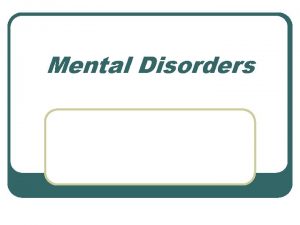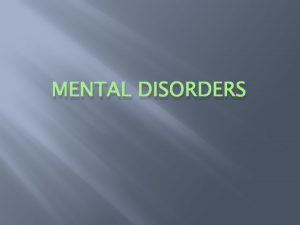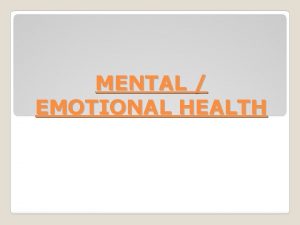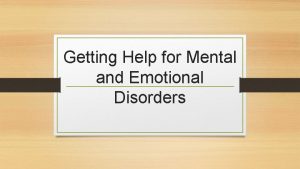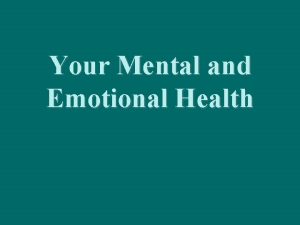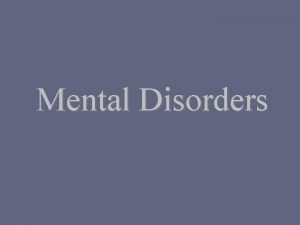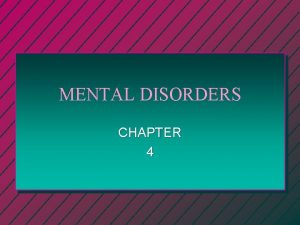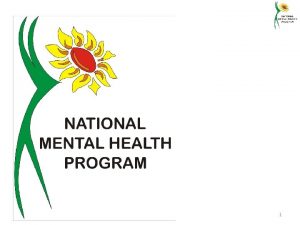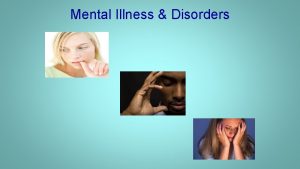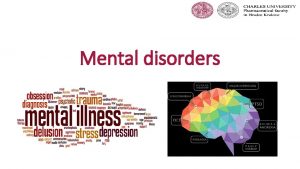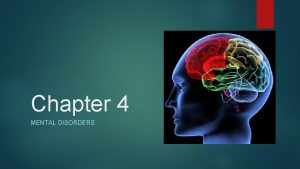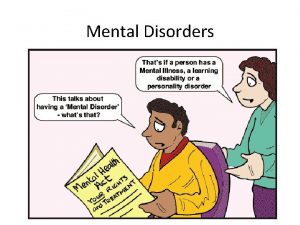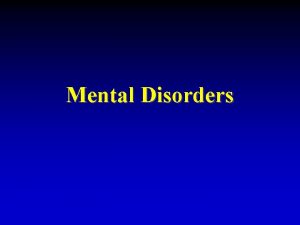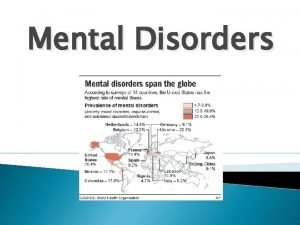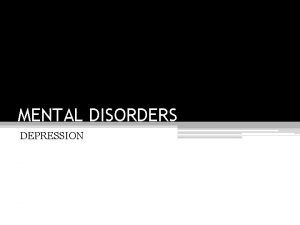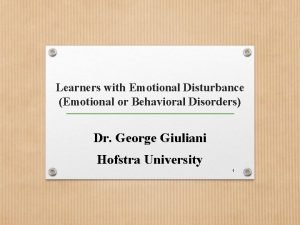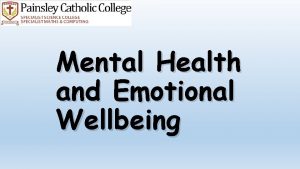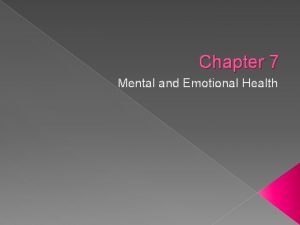Mental and Emotional Disorders Mental and Emotional Disorders





























- Slides: 29

Mental and Emotional Disorders

Mental and Emotional Disorders are an illnesses that affects a person’s thoughts, feelings and behaviors; affects the mind and reduces a person's ability to function, to adjust to change, or to get along with others. Example: mental disorders can affect a person's ability to study, keep a job, or make friends.

Mental and Emotional Disorders Mental health experts see abnormal thoughts and feelings, or behaviors as signs or symptoms of a mental disorder. These “abnormal” thoughts, feelings and behaviors are highly unusual or inappropriate for a given situation.

Causes… � Physical factors: Damage to the brain- tumor, injury; imbalance of chemicals in the brain � Heredity: the person is at a greater risk Life Experiences � Early Experiences: traumatic negative experiences- neglect or abuse as a child � Recent Experiences: death of a loved one

Anxiety Disorders Anxiety: fear caused by a source you cannot identify or a source that doesn't pose as much threat as you think. Anxiety disorder: extreme fears of real or imaginary situations that get in the way of normal activities

Anxiety Disorders Generalized Anxiety Disorder: no identifiable source of anxiety- restlessness, fatigue, trouble sleeping and concentrating Phobias: Intense and exaggerated fear of a specific situation or object Panic Attacks: a person will experience- fast heart rate, sweating, choking sensation, rapid breathing, fear of losing control, an "out of body" sensation, fear of suffocation

Anxiety Disorders Obsessive-Compulsive Disorder: a pattern of repeated thoughts/actions which force a person to do certain tasks over and over Obsession- an unwanted thought or image that takes control of the mind Compulsion- an unreasonable need to behave in a certain way to prevent a feared outcome Post-Traumatic Stress Disorder: characterized by bad memories in reaction to life-threatening event; they may have flashbacks or nightmares that produce intense fear or horror. (unable to sleep or concentrate)

Other Mental Disorders � Mood Disorder: person undergoes mood swings that seem extreme, inappropriate, last a long time, or make it difficult to function in daily life Example: manic-depressive/bipolar disorder- shift from one mood to another with no apparent reason

Other Mental Disorders Depression: person feels a strong sense of hopelessness, helplessness, worthlessness, guilt and extreme sadness (occur over long periods) Schizophrenia: incurable mental and emotional illness characterized by paranoia and hallucinations

Other Mental Disorders Impulse-control Disorder: cannot resist the impulse or drive, to act in a way that is harmful to themselves or to others. Examples: gambling- mostly males uncontrollable shopping- 85% females

Other Mental Disorders �Personality Disorder: display rigid patterns of behavior that make it difficult to get along with others � Group A– usually cold and distant; paranoid disorder – someone who is overly suspicious of other people � Group B– overly emotional/unstable and can be selfish; antisocial personality disorder– commit violent acts without any sense of guilt � Group C– cannot make decisions; dependent personality disorder- need help from others to properly care for themselves

Suicide and Depression

Suicide Vocabulary major depression suicide A very serious mood disorder in which people lose interest in life and can no longer find enjoyment in anything The act of killing oneself on purpose

Suicide: Intentional killing of oneself �The 3 rd leading cause of death among young people ages 15 -24 �Affects many different people: young, old, bright, poor, rich, male, female �Depression can lead to suicide �A suicide threat is a desperate attempt to ask for HELP �Most common treatment is hospitalization

Cluster Suicides A series of suicides that occur within a short period of time in the same group or community Some involve a pact between friends

Causes of Teen Suicide Teens are at greater risk of suicide if they: • have family members who suffer from depression. • are living in poverty. • are using alcohol or drugs. • experience abuse or violence family. • are victims of bullying. • experience major stress.

Causes of Teen Suicide Major Risk Factor: Depression Feelings of hopelessness or isolation Feeling like he/she has no friends A previous suicide attempt or family history of suicide Being influenced by the suicide of family members, peers, friends or celebrities Having a mental disorder and a substance abuse disorder Lack of access to mental health treatment

Warning Signs of Suicide • Talking about suicide or death • Talking about feeling hopeless, guilty, or worthless • Pulling away from family and friends • Loss of interest in normal activities • Sudden lack of attention to personal appearance

Warning Signs of Suicide • Self-destructive behaviors, such as violence, substance abuse, or running away • Constant boredom, trouble concentrating, or a sudden drop in grades • Giving away favorite belongings • Becoming suddenly cheerful after a long period of depression

Protective Factors/Prevention �Treating a person’s mental disorder (especially depression) �Treatment for abuse of alcohol or other drugs �Feeling connected to school, friends, family and others in the community �Having personal beliefs that discourage suicide �Knowing how to resolve problems in a nonviolent manner

How to Help a Suicidal Person �DO Trust your feelings if you believe a person may be suicidal Take seriously a suicidal person’s threats Tell the suicidal person how concerned you are and how much you care for him or her Listen carefully to the suicidal person Talk calmly with the suicidal person Find professional help for the suicidal person. Stay with the suicidal person until help arrives

How to Help a Suicidal Person �DO NOT Dare the suicidal person to go ahead and make the suicide attempt Judge the suicidal person Analyze the suicidal person’s motives Argue or try to convince the suicidal person of reasons why he/she should not attempt suicide Keep the suicidal person’s self-destructive thoughts or actions a secret Leave a suicidal person alone.

Treatment of Mental Disorders

When to Get Help Seek help right away for any of the following symptoms: • Feelings of sadness, anger, anxiety, or fear that don’t go away • Changes in eating or sleeping patterns • Wanting to be alone all the time • A feeling of being out of control • Loss of interest in favorite activities • Doing much worse in school all of a sudden • Hearing voices • Thoughts of suicide

Why are many people unwilling to seek help for mental/emotional disorders? �Person does not realize they have a illness �Blame the illness on a personal weakness �Embarrassment �Fear of being labeled “crazy”

Mental Health Professionals: � Psychiatrist – physician who diagnoses and treats mental disorders Are able to prescribe medication � Neurologist – physician who treats physical disorders of the nervous system � Clinical Psychologist – trained to recognize and treat behavior that is not normal Cannot prescribe medication, not medical doctors

Mental Health Professionals Cont. � Psychiatric Social Worker – helps people with mental disorders and their families accept and adjust to an illness � Mental Health Counselor – focus on specific problems or work with specific groups ex. substance abuse counselors, school counselors

Kinds of Treatment: � Psychotherapy – a person talks with their therapist Insight Therapy – helps better understand the reasons for their behavior Cognitive and Behavioral Therapy – helps person identify situations, objects or thoughts that trigger abnormal behaviors Group Therapy – people meet with other people with the same disorder

Kinds of Treatment Cont. �Drug Therapy – to treat mental disorders, relieve symptoms, allow patients to function normally �Hospitalization – need constant attention or are in danger of harming themselves or others
 Assistive technology for emotional disturbance
Assistive technology for emotional disturbance Chapter 21 mental health diseases and disorders
Chapter 21 mental health diseases and disorders Section 4-1 mental disorders answers
Section 4-1 mental disorders answers Section 4-1 mental disorders answers
Section 4-1 mental disorders answers Glencoe health chapter 5 review answers
Glencoe health chapter 5 review answers Chapter 5 lesson 2 mental disorders
Chapter 5 lesson 2 mental disorders Classification of mental illness
Classification of mental illness Mental health disorders
Mental health disorders Chapter 3 lesson 3 expressing emotions in healthful ways
Chapter 3 lesson 3 expressing emotions in healthful ways Chapter 5 lesson 4 getting help
Chapter 5 lesson 4 getting help Mental vs emotional
Mental vs emotional Chapter 3 achieving mental and emotional health
Chapter 3 achieving mental and emotional health Glencoe health chapter 3 lesson 1 answers
Glencoe health chapter 3 lesson 1 answers Chapter 5 lesson 3 health
Chapter 5 lesson 3 health Chapter 3 mental and emotional health
Chapter 3 mental and emotional health Chapter 3 achieving mental and emotional health
Chapter 3 achieving mental and emotional health Glencoe health ch 5
Glencoe health ch 5 Chapter 9 mental and emotional problems
Chapter 9 mental and emotional problems Emotional health defintion
Emotional health defintion Chapter 15 achieving mental and emotional health answer key
Chapter 15 achieving mental and emotional health answer key Is mental and emotional states preterite or imperfect
Is mental and emotional states preterite or imperfect Chapter 3 mental and emotional health
Chapter 3 mental and emotional health Chapter 3 achieving mental and emotional health
Chapter 3 achieving mental and emotional health Chapter 3 achieving mental and emotional health
Chapter 3 achieving mental and emotional health Lesson 2 developing personal identity and character
Lesson 2 developing personal identity and character Chapter 3 achieving mental and emotional health
Chapter 3 achieving mental and emotional health Chapter 15 achieving mental and emotional health
Chapter 15 achieving mental and emotional health Emotional health examples
Emotional health examples Mental vs emotional
Mental vs emotional Physical emotional mental spiritual
Physical emotional mental spiritual
